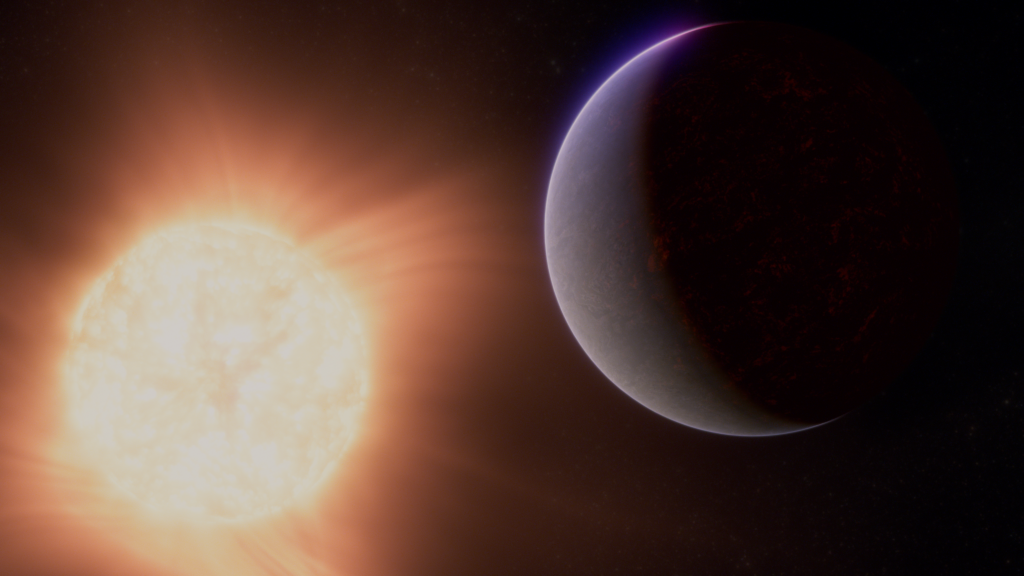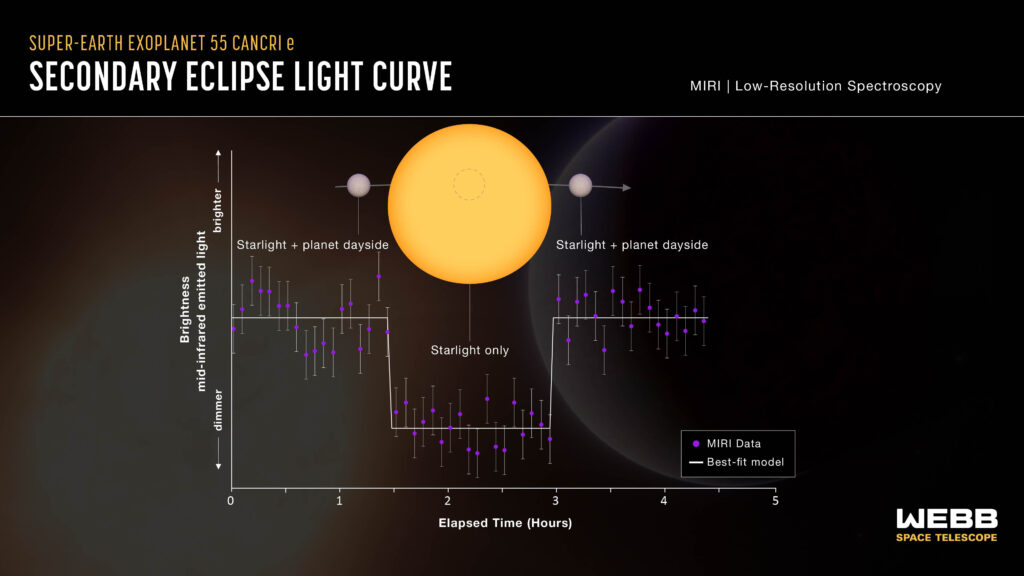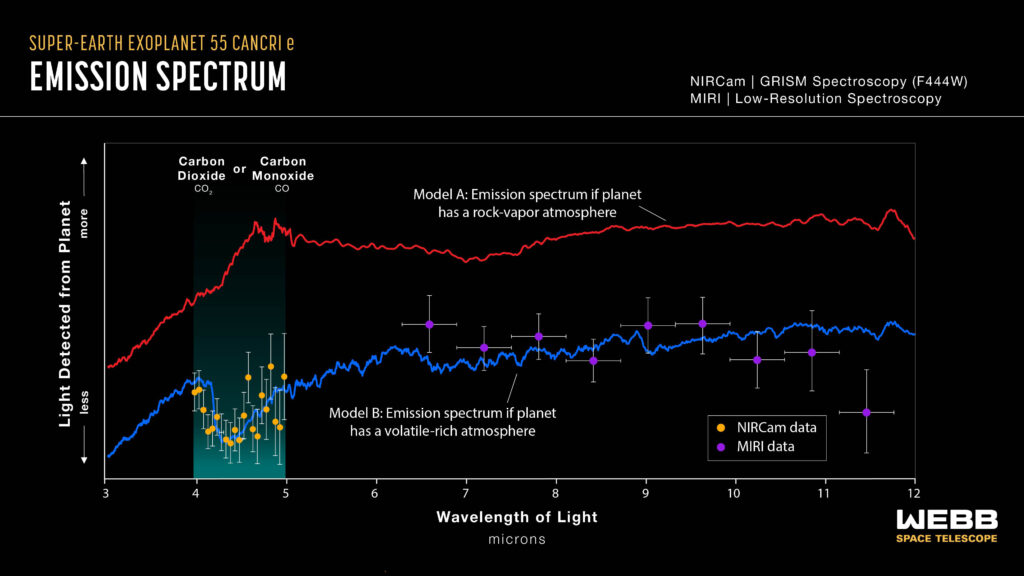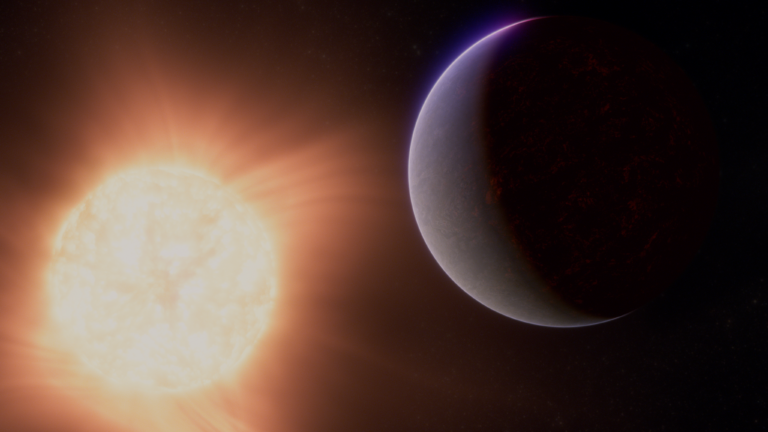NASA’s Webb Telescope Discover Presence of Atmosphere Enveloping Rocky Exoplanet.
The assertion made by researchers who are using the James Webb Space Telescope to observe 55 Cancri e, a close exoplanet that is rocky and 41 light years away from our planet, is that they may have identified some atmospheric gases around the exoplanet. This is a compelling clue making us believe that our system is not the only one where rocky planets can have an atmosphere.
Renyu Hu, a JPL scientist working on the same mission to JHUAPL in Maryland, is the paper’s lead author that was recently published in Nature. Webb plays an indisputable role in advancing the boundaries of exoplanet characterizations by rocky planets as Hu states. “It is indeed empowering the new type of science”, he points out.
Super-Hot Super-Earth 55 Cancri e
The other exoplanet that is quite close to us is Kepler-452b (pictured below, it can be also downloaded), that is one of the five planets orbiting the sun-like star Kepler-452, in the zodiacal constellation Cancer. With a diameter nearly twice that of Earth and density slightly greater, the planet is classified as a super-Earth: bigger than Earth, smaller than Neptune , and probably resembleable, in terms of material and composition, to the rocky planets of the solar system.
If 55 Cancri e is referred to as “rocky,” it might evoke a false image. The orbit of the planet around the star is just a bit more than one-twenty fifth of the Mercury-Sun distance (18 million miles), thus its surface is expected to be molten (a bubbling magma ocean). While such a tight orbit may give the planet a tidal lock state, where the dayside always faces the sun and the nightside is in full darkness through ever.
However, since its discovery and the first observations on its transit in 2011, the question of whether the world possesses any atmosphere – or must even possess an atmosphere given its high temperature and constant buffeting by the stellar radiation and the stellar wind from its host star – remains unsolved.
“I have served this world for more than ten years now,” she said Diana Dragomir, an exoplanet researcher at the University of New Mexico and one of the co-authors of the new study. “It becomes more and more complicated that no one can give us the strong clues with the results of our observations and measurements. What a relief! We can finally understand and start to uncover some of these mysteries!
In contrast to the easily detectable atmospheres of the gas giant planets, (which was discovered by NASA’s Hubble Space telescope over twenty years ago), the less dense and denser atmospheres around rocky planets have been a challenge to investigate.
Past works using Spitzer data, NASA’s observatory now decommissioned, imply that 55 Cancri e might own a hefty atmosphere of these gases like oxygen, nitrogen, and CO2. But researchers could not rule out another possibility: there would exist only the bare planet with its trivial atmosphere, mostly made of silicon, iron, aluminum, and calcium vapors. “The planet has such a high temperature that even some of the melted rocks start to boil,” said Hu.
Image: Super-Earth Exoplanet 55 Cancri e (Artist’s Concept)

NASA, ESA, CSA, Ralf Crawford (STScI)
Measuring Subtle Variations in Infrared Colors
To respond to this question a member of the team employed NIRCam and a MIRI to measure 4- to 12-micron infrared light coming to the planet from both objects.
Even though the Webb Telescope cannot create an image of the 55 Cancri e directly, it is capable of distinguishing a subtle change of light coming from the star system by the planet ditrihging it in the orbit.
They managed to do that simply by subtracting the peak of the planetary brightness characteristics (see Figure above, details/download) from the brightness of the star alone at aphelion, where the planet is hidden behind the star (starlight only) – that way the team could know the relative irradiation spectrum of the planetary dayside.
However, in contrast to the parameter used by other research teams whilst they are identifying atmospheres on the other rocky exoplanets, like TRAPPIST-1 b, this method is similar to a secondary eclipse spectroscopy.
Image: Super-Earth Exoplanet 55 Cancri e (MIRI Secondary Eclipse Light Curve)

Illustration: NASA, ESA, CSA, Joseph Olmsted (STScI) Science: Aaron Bello-Arufe (JPL)
Cooler than Expected
The first clue that 55 Cancri e might be wrapped around in considerable atmosphere was temperature measurements derived from its thermal emission (image graphic, details or download), or its radiation heat energy given out in the form of infrared light. If our close neighbor planet is covered in thick molten light rocks, and respectively with very little or maybe no atmosphere at all, the temperature at the day-sider should be around 2,200-4,000°C (~1,300-2,200°C).
Maintaining consistent data from the mission is crucial. In this regard, Hu stated, “In contrast what the MIRI data showed a relatively low temperature of about 2,800 degrees Fahrenheit [~1540 degrees Celsius]. ”“A good delnition is that an atmosphere would carry the heath which is more volatile than any other current”. On the same line, lava currents carry some heat to the darkside but cannot transfer it sufficiently enough to explain the cooling effect.
NIRCam data confirmed atmospheric volatile patterns. They are of the same type as what is observed for clouds and hurricanes here on earth. “We measure less light than what we are expecting around 4 to 5 microns in the spectrum, which indicates that maybe the planet has a big atmosphere under which CO or CO2 exists around this planet,” adds co-author Aaron Bello-Arufe from NASA JPL as well. CO and/or CO2 are known to absorb this spectrum of light, which is the evidence of their presence in the atmosphere at this planet.
“It’s been 10 years since we created the models and tried to visualize in our minds what the future of Earth can be, remarked the co-author Yamila Miguel from the observatory of Leiden University and the Netherlands Institute for space research (SRON). At last we have it the confirmation of our study and it is a dream come true!”
Image: Super-Earth Exoplanet 55 Cancri e (NIRCam + MIRI Emission Spectrum)

Illustration: NASA, ESA, CSA, Joseph Olmsted (STScI) Science: Renyu Hu (JPL), Aaron Bello-Arufe (JPL), Michael Zhang (University of Chicago), Mantas Zilinskas (SRON Netherlands Institute for Space Research)
Bubbling Magma Ocean
The team feels that most of the gases hidden onboard 55 Cancri e are exuding today instead of being a part of the inborn gas collection ever since the planet’s formation. “Probably, the original atmosphere would have long dissipated in the heat of the star and the radiation from the star itself,” said Bello-Arufe. Instead, there would create a secondary atmosphere that would be continuously replenished from the magma ocean. In fact, magma is not just rocks and liquid, but it also contains a lot of gas that is dissolved in it. ””
However, 55 Cancri e is more than twice the temperature of our Sun, which makes it too hot for any liquid water or life forms to exist there at all. Nevertheless, scientists think that 55 Cancri e can prove an excellent environment for testing how atmospheres, surfaces, and interiors of rocky worlds interact with each other, plus maybe give us some useful information on the conditions on Earth, Venus“Ultimately, we want to understand what conditions make it possible for a rocky planet to sustain a gas-rich atmosphere: the photosynthesis, the ultimate role of plants, is a fundamental building block for a habitable planet,” he explained.
This research was carried out during 1952 as a part of Webb Observatory (Phase A) (Managed Research Program). Assessing secondary eclipses observations new data points for 55 Cancri e, the results obtained so far recently are in prospect.
Source: Science NASA
Do not forget to share your opinion with us to provide you with the best posts !





0 Comments